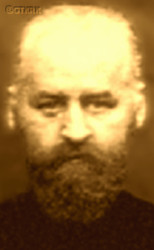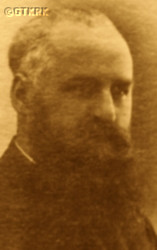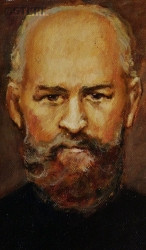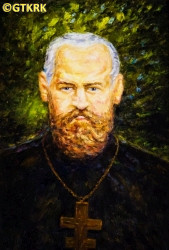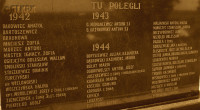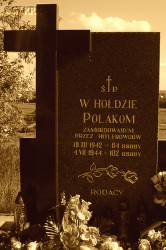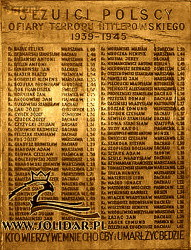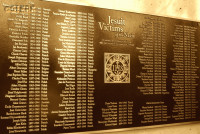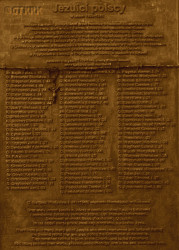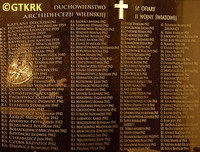Roman Catholic
St Sigismund parish
05-507 Słomczyn
85 Wiślana Str.
Konstancin deanery
Warsaw archdiocese, Poland
full list:
displayClick to display full list

searchClick to search full list by categories
wyświetlKliknij by wyświetlić pełną listę po polsku

szukajKliknij by przeszukać listę wg kategorii po polsku

Martyrology of the clergy — Poland
XX century (1914 – 1989)
personal data
surname
NIEMANCEWICZ
forename(s)
Anthony (pl. Antoni)
function
religious cleric
creed
Ukrainian Greek Catholic GCmore on
en.wikipedia.org
[access: 2013.05.19]
congregation
Society of Jesus SImore on
en.wikipedia.org
[access: 2014.09.21]
(i.e. Jesuits)
diocese / province
Greater Poland‐Mazovian province SI
Eastern Ritemore on
en.wikipedia.org
[access: 2017.03.11]
Lutsk diocesemore on
en.wikipedia.org
[access: 2013.05.19]
Mogilev archdiocesemore on
en.wikipedia.org
[access: 2013.06.23]
academic distinctions
Doctor of Law
Sacred Theology Candidate
nationality
Belarusian
date and place
of death
06.01.1943

Minsktoday: Minsk city reg., Belarus
more on
en.wikipedia.org
[access: 2020.07.31]
alt. dates and places
of death
02.12.1942, 01.04.1943
Berlintoday: Berlin state, Germany
more on
en.wikipedia.org
[access: 2020.07.31]
Petralevichitoday: Petralevichi 1 and Petralevichi 2, Pavlovo ssov., Slonim dist., Grodno reg., Belarus
more on
be.wikipedia.org
[access: 2023.01.18]
details of death
For the first time arrested on 25.05.1919 — by the Russians.
Released after half a year.
On 12.04.1920 arrested by the Russians again.
On 05.05.1920 sentenced to 6 months of slave labour.
On 31.05.1921 arrested again and on 02.08.1921 sentence do year of slave labour.
In 1923/4 arrested by the Russians once more and sentenced to 3 years of slave labour in Russian concentration camps — Gulag.
Jailed in Ivanovsky camp n. Moscow.
On 01.02.1925 released however and exchanged for Russian spies in Poland.
Yet another time arrested by the Germans after German and Russian invasion of Poland in 09.1939 and start of the World War II, after start of Russian occupation.
Held for a short time.
Finally after German attack on 22.06.1941 of their erstwhile ally, Russians, arrested on 08.1942 in Minsk (or in Białystok) — this time by the Germans.
Jailed in Minsk prison where perished.
His name appears also on a monument to those murdered at Petralevichi.
alt. details of death
According to other sources murdered on 02.12.1942 in a prison in Berlin.
According to yet another sources murdered in Petralevichi, place of mass executions perpetrated by Germans.
cause of death
murder
perpetrators
Germans
sites and events
MinskClick to display the description, Pietralewicka HillClick to display the description, Ribbentrop‐MolotovClick to display the description, Pius XI's encyclicalsClick to display the description, GulagClick to display the description
date and place
of birth
08.02.1893

Sankt Petersburgtoday: Saint Petersburg city, Russia
more on
en.wikipedia.org
[access: 2020.07.31]
presbyter (holy orders)
ordination
27.09.1915

positions held
from 1939
exarch – patriarch's legate — Catholic Church of the Byzantine–Belarusian rite
1935 – 1939
superior — Dubnotoday: Dubno urban hrom., Dubno rai., Rivne obl., Ukraine
more on
en.wikipedia.org
[access: 2020.11.27] ⋄ residence, Jesuits SI
1935 – 1939
professor — Dubnotoday: Dubno urban hrom., Dubno rai., Rivne obl., Ukraine
more on
en.wikipedia.org
[access: 2020.11.27] ⋄ Pontifical Seminary of the Eastern Rite, residence, Jesuits SI
friar — Albertintoday: part of Slonim, Slonim dist., Grodno reg., Belarus
more on
en.wikipedia.org
[access: 2021.09.29] ⋄ Sacred Heart of Jesus monastery (known as Eastern Mission), Jesuits SI
friar — Synkavichytoday: Synkavichy ssov., Zeľva dist., Grodno reg., Belarus
more on
en.wikipedia.org
[access: 2022.01.06] ⋄ Transfiguration of the Lord BS residency (known as Eastern Mission), Jesuits SI
1929
accession — Albertintoday: part of Slonim, Slonim dist., Grodno reg., Belarus
more on
en.wikipedia.org
[access: 2021.09.29] ⋄ Sacred Heart of Jesus monastery (known as Eastern Mission), Jesuits SI
1928 – 1929
senior assistant — Lublintoday: Lublin city pov., Lublin voiv., Poland
more on
en.wikipedia.org
[access: 2021.08.20] ⋄ comparative theology, Catholic University of Lublin KUL [i.e. Catholic University of Lublin KUL (since 1928) / clandestine Catholic University of Lublin KUL (1939‐1944) / University of Lublin (1918‐1928)]
lecturer — Lublintoday: Lublin city pov., Lublin voiv., Poland
more on
en.wikipedia.org
[access: 2021.08.20] ⋄ Mission Institute
c. 1925 – 1927
PhD student — Rometoday: Rome prov., Lazio reg., Italy
more on
en.wikipedia.org
[access: 2021.12.18] ⋄ Pontifical Oriental Institute (Lat. Pontificium Institutum Orientale) — public defense PhD thesis in 1927, published as „Bolshevism and education”, Lublin, 1929
till 1921
vicar — Moscowtoday: Moscow city, Russia
more on
en.wikipedia.org
[access: 2020.07.31] ⋄ St Peter and St Paul the Apostles RC parish ⋄ Moscowtoday: Moscow city, Russia
more on
en.wikipedia.org
[access: 2020.07.31] RC deanery
priest — Kolpinotoday: Kolpino reg., Saint Petersburg city, Russia
more on
en.wikipedia.org
[access: 2022.01.06] ⋄ St Peter and St Paul the Apostles RC parish ⋄ Sankt Petersburgtoday: Saint Petersburg city, Russia
more on
en.wikipedia.org
[access: 2020.07.31] RC deanery
c. 1915 – 1918
student — Sankt Petersburgtoday: Saint Petersburg city, Russia
more on
en.wikipedia.org
[access: 2020.07.31] ⋄ philosophy and theology, Imperial Roman Catholic Spiritual Academy (1842‐1918) — postgraduate specialised studies crowned with Sacred Theology Candidate's degree
1910 – c. 1915
student — Sankt Petersburgtoday: Saint Petersburg city, Russia
more on
en.wikipedia.org
[access: 2020.07.31] ⋄ philosophy and theology, Metropolitan Theological Seminary
others related
in death
HERMATIUKClick to display biography John
sites and events
descriptions
Minsk: Russian prison. In 1937 site of mass murders perpetrated by the Russians during a „Great Purge”. After Russian invasion of Poland in 09.1939 and start of the World War II place of incarceration of many Poles, In 06.1941, under attack by Germans, Russians murdered there a group of Polish prisoner kept in Central and co‐called American prisons in Mińsk. The rest were driven towards Chervyen in a „death march” (10,000‐20,000 prisoners perished), into Russia. (more on: pl.wikipedia.orgClick to attempt to display webpage
[access: 2013.08.17])
Pietralewicka Hill: A small hill nearby Pietralewicze village by the Baranavichy town, place of German mass murders, mainly Jews, but also of local Polish intelligentsia. From 10,000 to 21, 000 victims might have been murdered there (or even as many as 42,000). (more on: kresowiacy.comClick to attempt to display webpage
[access: 2013.12.27], www.sztetl.org.plClick to attempt to display webpage
[access: 2013.12.27])
Ribbentrop‐Molotov: Genocidal Russian‐German alliance pact between Russian leader Joseph Stalin and German leader Adolf Hitler signed on 23.08.1939 in Moscow by respective foreign ministers, Mr. Vyacheslav Molotov for Russia and Joachim von Ribbentrop for Germany. The pact sanctioned and was the direct cause of joint Russian and German invasion of Poland and the outbreak of the World War II in 09.1939. In a political sense, the pact was an attempt to restore the status quo ante before 1914, with one exception, namely the „commercial” exchange of the so‐called „Kingdom of Poland”, which in 1914 was part of the Russian Empire, fore Eastern Galicia (today's western Ukraine), in 1914 belonging to the Austro‐Hungarian Empire. Galicia, including Lviv, was to be taken over by the Russians, the „Kingdom of Poland” — under the name of the General Governorate — Germany. The resultant „war was one of the greatest calamities and dramas of humanity in history, for two atheistic and anti‐Christian ideologies — national and international socialism — rejected God and His fifth Decalogue commandment: Thou shall not kill!” (Abp Stanislav Gądecki, 01.09.2019). The decisions taken — backed up by the betrayal of the formal allies of Poland, France and Germany, which on 12.09.1939, at a joint conference in Abbeville, decided not to provide aid to attacked Poland and not to take military action against Germany (a clear breach of treaty obligations with Poland) — were on 28.09.1939 slightly altered and made more precise when a treaty on „German‐Russian boundaries and friendship” was agreed by the same murderous signatories. One of its findings was establishment of spheres of influence in Central and Eastern Europe and in consequence IV partition of Poland. In one of its secret annexes agreed, that: „the Signatories will not tolerate on its respective territories any Polish propaganda that affects the territory of the other Side. On their respective territories they will suppress all such propaganda and inform each other of the measures taken to accomplish it”. The agreements resulted in a series of meeting between two genocidal organization representing both sides — German Gestapo and Russian NKVD when coordination of efforts to exterminate Polish intelligentsia and Polish leading classes (in Germany called «Intelligenzaktion», in Russia took the form of Katyń massacres) where discussed. Resulted in deaths of hundreds of thousands of Polish intelligentsia, including thousands of priests presented here, and tens of millions of ordinary people,. The results of this Russian‐German pact lasted till 1989 and are still in evidence even today. (more on: en.wikipedia.orgClick to attempt to display webpage
[access: 2015.09.30])
Pius XI's encyclicals: Facing the creation of two totalitarian systems in Europe, which seemed to compete with each other, though there were more similarities than contradictions between them, Pope Pius XI issued in 03.1937 (within 5 days) two encyclicals. In the „Mit brennender Sorge” (Eng. „With Burning Concern”) published on 14.03.1938, condemned the national socialism prevailing in Germany. The Pope wrote: „Whoever, following the old Germanic‐pre‐Christian beliefs, puts various impersonal fate in the place of a personal God, denies the wisdom of God and Providence […], whoever exalts earthly values: race or nation, or state, or state system, representatives of state power or other fundamental values of human society, […] and makes them the highest standard of all values, including religious ones, and idolizes them, this one […] is far from true faith in God and from a worldview corresponding to such faith”. On 19.03.1937, published „Divini Redemptoris” (Eng. „Divine Redeemer”), in which criticized Russian communism, dialectical materialism and the class struggle theory. The Pope wrote: „Communism deprives man of freedom, and therefore the spiritual basis of all life norms. It deprives the human person of all his dignity and any moral support with which he could resist the onslaught of blind passions […] This is the new gospel that Bolshevik and godless communism preaches as a message of salvation and redemption of humanity”… Pius XI demanded that the established human law be subjected to the natural law of God , recommended the implementation of the ideal of a Christian state and society, and called on Catholics to resist. Two years later, National Socialist Germany and Communist Russia came together and started World War II. (more on: www.vatican.vaClick to attempt to display webpage
[access: 2023.05.28], www.vatican.vaClick to attempt to display webpage
[access: 2023.05.28])
Gulag: The acronym Gulag comes from the Rus. Главное управление исправительно‐трудовых лагерей и колоний (Eng. Main Board of Correctional Labor Camps). The network of Russian concentration camps for slave labor was formally established by the decision of the highest Russian authorities on 27.06.1929. Control was taken over by the OGPU, the predecessor of the genocidal NKVD (from 1934) and the MGB (from 1946). Individual gulags (camps) were often established in remote, sparsely populated areas, where industrial or transport facilities important for the Russian state were built. They were modeled on the first „great construction of communism”, the White Sea‐Baltic Canal (1931‐1932), and Naftali Frenkel, of Jewish origin, is considered the creator of the system of using forced slave labor within the Gulag. He went down in history as the author of the principle „We have to squeeze everything out of the prisoner in the first three months — then nothing is there for us”. He was to be the creator, according to Alexander Solzhenitsyn, of the so‐called „Boiler system”, i.e. the dependence of food rations on working out a certain percentage of the norm. The term ZEK — prisoner — i.e. Rus. заключенный‐каналоармец (Eng. canal soldier) — was coined in the ITL BelBaltLag managed by him, and was adopted to mean a prisoner in Russian slave labor camps. Up to 12 mln prisoners were held in Gulag camps at one time, i.e. c. 5% of Russia's population. In his book „The Gulag Archipelago”, Solzhenitsyn estimated that c. 60 mln people were killed in the Gulag until 1956. Formally dissolved on 20.01.1960. (more on: en.wikipedia.orgClick to attempt to display webpage
[access: 2024.04.08])
sources
personal:
kamunikat.orgClick to attempt to display webpage
[access: 2013.01.06], www.bj.uj.edu.plClick to attempt to display webpage
[access: 2012.11.23], www.katolicy.euClick to attempt to display webpage
[access: 2021.12.19], echapolesia.plClick to attempt to display webpage
[access: 2013.08.10], pl.wikipedia.orgClick to attempt to display webpage
[access: 2013.08.10], archive.todayClick to attempt to display webpage
[access: 2021.12.19]
bibliographical:
„Vilnius archdiocese clergy martyrology 1939‐1945”, Fr Thaddeus Krahel, Białystok, 2017
„Jesuits on Polish and Lithuanian territory knowledge encyclopedia, 1564‐1995”, Fr Louis Grzebień SI (editor), WAM Printing House, Cracow 1996
„Fate of the Catholic clergy in USSR 1917‐1939. Martyrology”, Roman Dzwonkowski, SAC, ed. Science Society KUL, 2003, Lublin
original images:
kamunikat.fontel.netClick to attempt to display webpage
[access: 2015.04.18], cyclowiki.orgClick to attempt to display webpage
[access: 2021.12.19], www.facebook.comClick to attempt to display webpage
[access: 2020.01.06], www.flickr.comClick to attempt to display webpage
[access: 2014.01.06], www.flickr.comClick to attempt to display webpage
[access: 2014.01.06], www.sowiniec.com.plClick to attempt to display webpage
[access: 2016.03.14], college.holycross.eduClick to attempt to display webpage
[access: 2013.05.19], www.miejscapamiecinarodowej.plClick to attempt to display webpage
[access: 2014.05.09], ipn.gov.plClick to attempt to display webpage
[access: 2019.02.02], www.ciekawepodlasie.plClick to attempt to display webpage
[access: 2020.07.31]
LETTER to CUSTODIAN/ADMINISTRATOR
If you have an Email client on your communicator/computer — such as Mozilla Thunderbird, Windows Mail or Microsoft Outlook, described at WikipediaPatrz:
en.wikipedia.org, among others — try the link below, please:
LETTER to CUSTODIAN/ADMINISTRATORClick and try to call your own Email client
If however you do not run such a client or the above link is not active please send an email to the Custodian/Administrator using your account — in your customary email/correspondence engine — at the following address:

giving the following as the subject:
MARTYROLOGY: NIEMANCEWICZ Anthony
To return to the biography press below:
 Click to return to biography
Click to return to biography








